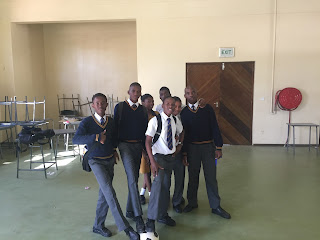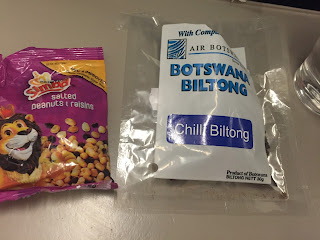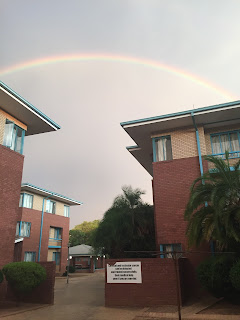For the project, each group had to choose a traditional
game, go out into the community, observe people playing the game and then
uncover the mathematics used in the game.
Our first mistake from a few weeks ago was choosing a game that is not
played around here. We thought we
could read about it online and then discuss the mathematics and were thinking
about choosing mancala . When we talked about it with the lecturer, he asked if
others had written about the mathematics of this game. I proudly thought “yes!” thinking that
we had found a good one. He said
that others have already done the work that we needed to do for this
project. I was missing the whole
point of the assignment, thinking he wanted a report of what researchers have
said about the game. No, he wanted
us to experience the game and actually uncover the mathematics ourselves. This makes total sense now and is a
much better idea.
My class at GSS ended at 10:00 and I told the students that
I was looking for five or six volunteers to help with a group project for the
university. I’d been working with this class every
day for two and a half weeks and I was thrilled that many of them were willing
to stay after class and talk to me.
I had a list of three games from one of my group mates and they agreed
to show us how to play maroundas at 1:00pm dismissal. They said they would need a ball like a football (soccer
ball). One of the students walked
me over to where we should all meet up later. This will become important later in the story.
At 12:30, the running late texts from my UB group members started
coming in and I was starting to get anxious because we had already missed many
group meetings before. I got to
the spot a few minutes before dismissal.
The students have lunch from 1:00-2:00 and then various types of study
and activities from 2:00-4:00, but classes are finished for the day at
1:00. I was surprised that I
didn’t see the students from my class because they seemed so eager to
volunteer. I began to question
myself. Are they here and I am
just not recognizing them? I walked
up to random groups of confused students, who I’m sure were wondering what this
lady with the football wants. When
of my group members arrived I told him I wasn’t sure where the kids from my class
were, but maybe we could just go up to random students and ask them to help us
out. I must have been riding the
high from the eagerness to volunteer earlier because the students that we
didn’t know had no interest in helping us play a game. Most were familiar with the game but said
they would need many people to play, twelve or so. This confused me because my students didn’t say anything
about needing so many players. At
this point, I still had no clue how this game is played. I think the students that we didn’t
know felt like it would be a lot of effort and possibly socially risky to try
to strike up a game on the spot for adults they didn’t know. I was frustrated that no one wanted to
help us, but I think I understand the reasons now. Our third group member showed up at some point during all
this. They wanted to postpone for
another time and I definitely was feeling the opposite, like I wanted to start
bribing students if necessary. It
wasn’t working and Ivy said she could make a video of some younger children
playing one of the other games that was suggested to us. We agreed to meet the next day at 2:00
and I was disappointed and not feeling well. Oh, and in the middle of all of this, one of our group
members got a text that another group already chose maroundas and we couldn’t
do it anyway. This is why Ivy said
she would find children playing one of the other games. I was also very confused and frustrated
by this. How were we supposed to
know that another group chose it?
There was never a process for groups choosing a game, it wasn’t written
on the group sign-up sheet and the lecturer never said anything about this
being a problem. I set back into
the school grounds, defeated, to find the owner of the football (who had driven
home earlier in the day to pick it up for us) and return it.
When I turned the corner of the big building that we had all
been in front of for the past 45 minutes, I ran smack dab into my
students! They were at a different
entrance to the building and were cheerfully wondering where I was. It turned out that the student who
showed me where to meet was not actually a part of our class and so she took me
to the front entrance of the building, but my group was waiting for me at the
side entrance that leads directly into the auditorium. How could I have been confused about
which students were from my class?
I recognized them immediately.
I did not tell them any of the drama of the past 45 minutes, we just
went into the gym and played the game.
The students had failed to mention they needed chalk to make
the playing area, but I imagine that could be improvised if there was no
chalk. I happened to have a few
pieces in my pocket from class. A
student made a playing area on the floor.
There seem to be many different variations, but this is is how
a student explained it.
There are two teams.
A player from one team stands in the circle on the left and is the
kicker. A player from the other
team stands in the other circle and is the pitcher. It is basically a very simplified version of kickball. The pitcher rolls the ball and the
kicker must put the ball in play.
The pitcher runs after the ball and brings it back to the circle. Meanwhile, the kicker is running back
and forth between the two circles scoring points. When the pitcher gets back to the circle with the ball, the
kicker must be back on his/her own side of the centerline. If the kicker is caught on the
pitcher’s side of the centerline, the kicker is out. The kicker is also out if the pitcher catches the kicked
ball in the air or if the kicker didn’t kick the ball past the centerline (must
kick it forward, not to the side, no foul balls). The game is over when all the players from one team get
out. I asked about the points that
were accumulating while the kicker is running back and forth. They said you could also play according
to points or that scoring can be used to get players from your team who are out
back in the game. Also, some of
them said that you score a point each time you get to a circle and others said
you score a point each time you get back to your own circle.
I’m still not sure what the name of this game is. According to the GSS students, this is maroundas. When I got home, I showed my housemates
a video and they said that maroundas is played using four circles, not two, and
this game is called “dila.” This
is interesting because if there were four circles, the playing would look much
more like baseball, and “maroundas” sounds like “rounders.” So maybe that is
the connection.

























































